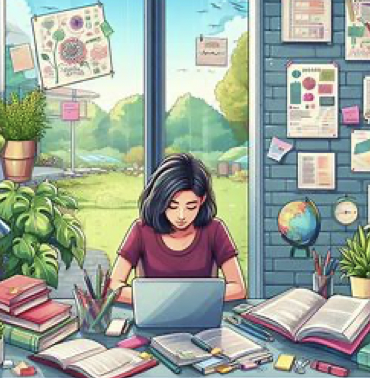Graphic design is a dynamic field that combines creativity and technology to communicate ideas.
It’s a discipline that requires a keen eye for aesthetics, a deep understanding of visual communication, and the ability to use various tools and software.
For those who are interested in this field but can’t afford or don’t have the time to attend a traditional design school, self-study can be a viable option.
This article will provide a comprehensive self-study map for graphic design, guiding you through the necessary steps to become a proficient graphic designer.
Self-Study Map for Graphic Design
- Introduction to Design: Grasp the importance, scope, and evolution of graphic design.
- Design Principles: Understand balance, contrast, hierarchy, alignment, and repetition.
- Typography: Explore font types, kerning, leading, and typographic best practices.
- Color Theory: Dive into color wheels, schemes, psychology, and application.
- Layout & Composition: Grasp grids, whitespace, balance, and structuring visuals.
- Branding & Identity: Study logo design, brand guidelines, and corporate identity.
- Print Design: Understand brochures, business cards, posters, and print specifications.
- Digital Design: Explore web design, mobile UI, social media graphics, and responsiveness.
- Illustration: Dive into digital drawing, vector graphics, and hand-drawn techniques.
- Photo Editing: Master tools for retouching, color correction, and image manipulation.
- Design Software: Get proficient in Adobe Suite (Illustrator, Photoshop, InDesign) and alternatives.
- UX/UI Design: Understand user experience, interface design, and wireframing.
- Animation & Motion Graphics: Grasp basics of animation, keyframes, and video graphics.
- 3D Design: Dive into basic 3D modeling, texturing, and rendering.
- Packaging Design: Study material choices, structural design, and print finishes.
- Portfolio Development: Create a comprehensive showcase of your best work.
- Design History & Theory: Explore design movements, iconic designers, and their impact.
- Critiques & Feedback: Engage in peer reviews to refine and improve designs.
- Industry Trends: Stay updated on current design trends, technologies, and tools.
- Join Design Communities: Connect with professionals on platforms like Behance, Dribbble.
- Hands-on Projects: Apply skills through real-world projects and challenges.
- Read Design Blogs & Books: Immerse in resources like “AIGA Eye on Design” or “Design of Everyday Things”.
- Continuous Learning: Design is dynamic; always be receptive to new techniques and styles.
Table of Contents
Understanding Graphic Design
Before diving into the technical aspects of graphic design, it’s crucial to understand what it entails.
Graphic design is about solving problems through visual communication. It involves creating visual content to communicate messages.
Designers apply visual hierarchy and page layout techniques, along with typography and pictures, to meet users’ specific needs and focus on the logic of displaying elements in interactive designs to optimize the user experience.
Essential Skills for Graphic Design
There are several key skills that every graphic designer should master. These include:
- Visual Aesthetic: A good designer should have a keen eye for color, composition, and typography.
- Technical Skills: Proficiency in design software, primarily Adobe Creative Suite, is essential.
- Communication Skills: Designers must be able to articulate their ideas clearly and effectively.
- Critical Thinking: Design is problem-solving. Designers should be able to analyze a problem and come up with a creative solution.
Self-Study Resources
There are numerous resources available for those who wish to self-study graphic design. These include:
- Online Courses: Websites like Coursera, Udemy, and Skillshare offer comprehensive courses on graphic design.
- Books: Books like “The Elements of Graphic Design” and “Graphic Design: The New Basics” provide valuable insights into the field.
- Design Blogs and Websites: Websites like Smashing Magazine and Behance offer a wealth of information and inspiration.
- Practice: The best way to learn design is by doing. Regularly working on design projects can help you hone your skills.
Creating a Portfolio
A portfolio is a crucial part of any designer’s toolkit.
It showcases your work, demonstrates your skills, and gives potential clients or employers an idea of what you can do.
When creating a portfolio, remember to include a variety of work that shows your versatility and skill set.
Also, ensure that each piece is accompanied by a brief description that explains your design process and the problem you were trying to solve.
FAQs on Self-Study Map for Graphic Design
1. Can I become a graphic designer without a degree?
Yes, it’s possible to become a graphic designer without a degree. Many successful designers are self-taught.
What matters most is your portfolio and your ability to demonstrate your skills and creativity.
2. What are the essential software tools for graphic design?
The Adobe Creative Suite, which includes Photoshop, Illustrator, and InDesign, is the most commonly used software in graphic design.
Other tools include Sketch, Canva, and CorelDRAW.
3. How can I practice graphic design?
You can practice graphic design by working on personal projects, participating in design challenges, or doing freelance work.
The key is to consistently create and seek feedback on your work.
4. What should I include in my graphic design portfolio?
Your portfolio should include a variety of work that demonstrates your skills and versatility.
It should also include a brief description of each piece, explaining your design process and the problem you were trying to solve.
5. How long does it take to become a graphic designer through self-study?
The time it takes to become a graphic designer through self-study varies depending on the individual’s dedication and the amount of time they can devote to learning and practicing.
On average, it can take anywhere from six months to a few years.
Summary – Self-Study Map for Graphic Design
Self-studying graphic design is a viable option for those who are passionate about the field but can’t attend a traditional design school.
By understanding the basics of design, mastering essential skills, utilizing available resources, and creating a compelling portfolio, you can become a proficient graphic designer.
The key to success in design is practice and continuous learning.
Related
- Self-Study Map for Statistics
- Self-Study Map for Mathematics
- Self-Study Map for Computer Science
- Self-Study Map for Psychology
- Self-Study Map for Nursing
- Self-Study Map for Business Administration
- Self-Study Map for Pharmacy
- Self-Study Map for Mechanical Engineering
- Self-Study Map for Civil Engineering
- Self-Study Map for Electrical Engineering
- Self-Study Map for Sociology
- Self-Study Map for Physics
- Self-Study Map for Philosophy
- Self-Study Map for Chemistry
- Self-Study Map for Political Science
- Self-Study Map for Communication Studies
- Self-Study Map for Education
- Self-Study Map for Marketing
- Self-Study Map for Accounting
- Self-Study Map for Music
- Self-Study Map for Law
- Self-Study Map for Medicine
- Self-Study Map for Drama and Theater Studies
- Self-Study Map for Anthropology
- Self-Study Map for Art History
- Self-Study Map for Environmental Science
- Self-Study Map for English Literature
- Self-Study Map for History
- Self-Study Map for Information Technology


